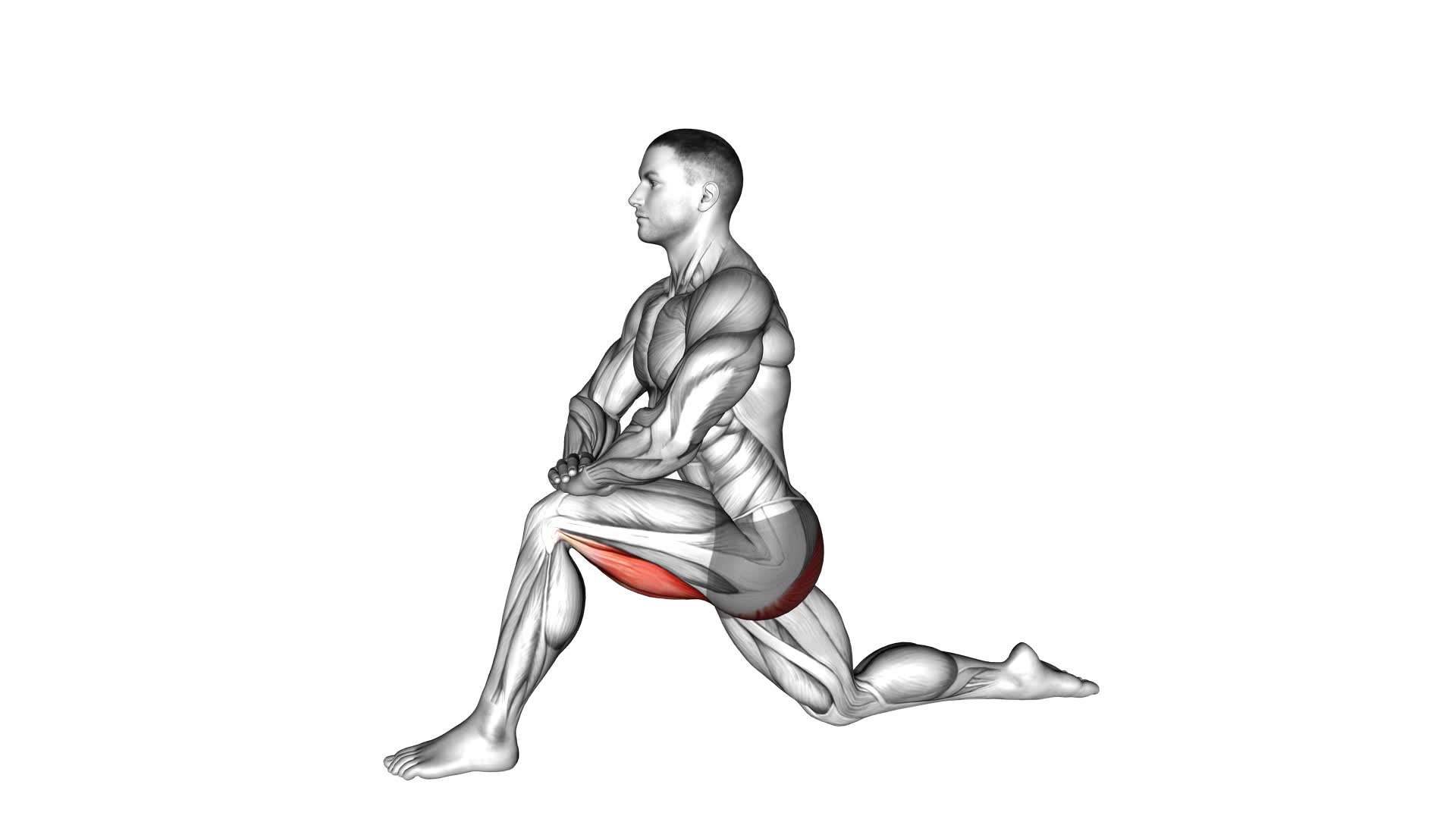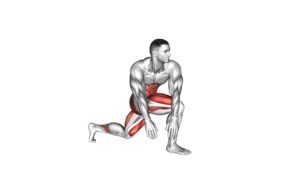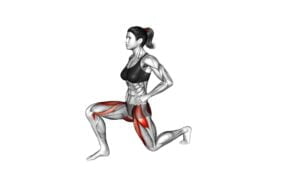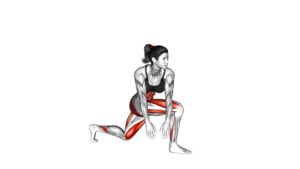Kneeling Hip Flexor Stretch – Video Exercise Guide & Tips

Are you looking to improve your hip flexibility and relieve tightness?
Watch This Exercise Video
Then the Kneeling Hip Flexor Stretch is perfect for you! This quick and effective exercise targets the muscles in your hip flexors, helping to increase mobility and reduce discomfort.
In this video exercise guide, you'll learn the proper form and technique, as well as common mistakes to avoid.
Plus, we'll provide variations and tips to maximize the effectiveness of this stretch.
Get ready to feel the difference in your hips!
Key Takeaways
- Increases hip flexibility
- Reduces the risk of hip and lower back pain
- Enhances stability and balance
- Improves range of motion in activities like running and jumping
Benefits of the Kneeling Hip Flexor Stretch
Experience the numerous benefits of the kneeling hip flexor stretch. This stretch is an effective way to maximize flexibility and strengthen your hip muscles. By incorporating this stretch into your routine, you can improve your overall fitness and prevent injuries.
One of the key benefits of the kneeling hip flexor stretch is its ability to increase flexibility. This stretch targets the hip flexor muscles, which can become tight and shortened due to prolonged sitting or intense exercise. By performing this stretch regularly, you can lengthen these muscles, allowing for greater range of motion and improved performance in activities such as running, jumping, and squatting.
In addition to improving flexibility, the kneeling hip flexor stretch also helps to strengthen the hip muscles. This stretch specifically targets the iliopsoas muscle, which is responsible for flexing the hip joint. By strengthening this muscle, you can enhance your stability and balance, ultimately improving your athletic performance and reducing the risk of hip and lower back pain.
Incorporating the kneeling hip flexor stretch into your fitness routine is a practical and effective way to maximize flexibility and strengthen your hip muscles. By taking the time to perform this stretch regularly, you can reap the benefits of improved flexibility, increased strength, and reduced risk of injury.
Proper Form and Technique for the Stretch
To ensure you get the most out of the kneeling hip flexor stretch, it's important to focus on proper form and technique. By avoiding common mistakes such as arching your back or leaning too far forward, you can effectively target and stretch your hip flexors.
Proper form also maximizes the benefits of the stretch, including improved flexibility, reduced hip tightness, and enhanced posture.
Common Mistakes to Avoid
To ensure proper form and technique for the kneeling hip flexor stretch, it's important to avoid common mistakes. Here are some common mistakes to avoid and tips for proper technique:
- Incorrect alignment: Make sure your front knee is directly above your ankle and your back knee is directly below your hip. This will help target the hip flexors effectively.
- Leaning forward: Avoid leaning too far forward during the stretch. Instead, maintain an upright posture to avoid strain on your lower back.
- Not engaging the core: Engage your core muscles by pulling your belly button towards your spine. This will help stabilize your body and deepen the stretch.
- Overstretching: Don't push yourself too hard. Gradually increase the stretch and listen to your body's limits.
- Neglecting the back leg: Remember to also stretch the back leg by gently pushing your hips forward and down.
Benefits of Proper Form
By maintaining proper form and technique during the kneeling hip flexor stretch, you can optimize the benefits for your body.
One of the main benefits of proper form is maximizing flexibility. When you maintain the correct alignment and positioning of your body, you allow for a deeper stretch in the hip flexor muscles. This can help improve your range of motion and overall flexibility.
Additionally, proper form during this stretch can also help prevent hip pain. When you perform the stretch incorrectly, you may put unnecessary strain on your hip joints, leading to discomfort and potential injury.
Common Mistakes to Avoid
What are some common mistakes you should avoid when performing the kneeling hip flexor stretch? Proper execution is essential to maximize the benefits of this stretch and prevent injury. Here are some common mistakes to avoid:
- Rushing through the stretch: Take your time and focus on each movement to ensure proper form and effectiveness.
- Arching the back excessively: Maintain a neutral spine by engaging your core muscles and avoiding excessive arching, as this can strain the lower back.
- Tip: Imagine tucking your tailbone under and lengthening your spine throughout the stretch.
- Leaning forward too much: Keep your torso upright and avoid leaning forward excessively, as this can put unnecessary stress on the hips and negate the stretch.
- Tip: Engage your glutes and gently press your hips forward to deepen the stretch.
By avoiding these common mistakes, you can ensure a safer and more effective kneeling hip flexor stretch.
Now, let's explore variations and modifications for different fitness levels.
Variations and Modifications for Different Fitness Levels
For different fitness levels, there are various variations and modifications that can be made to the kneeling hip flexor stretch. If you're a beginner, it's important to start slow and focus on proper form. One modification you can make is to use a cushion or yoga block under your knee for added support and comfort. This will help reduce strain on the knee joint and allow you to maintain the stretch for a longer period of time. Another modification for beginners is to perform the stretch with the back knee resting on the ground instead of lifted. This will provide a less intense stretch while still targeting the hip flexors.
On the other hand, if you're more advanced and looking for a challenge, there are advanced variations of the kneeling hip flexor stretch that you can try. One variation is to add a twist to the stretch by rotating your torso towards the front leg. This will engage your obliques and add an extra stretch to the hip flexors. Another advanced variation is to perform the stretch on an unstable surface, such as a Bosu ball or a foam roller. This will require more core stability and balance, intensifying the stretch.
Now that you know about the variations and modifications for different fitness levels, let's move on to the next section about tips for maximizing the effectiveness of the stretch.
Tips for Maximizing the Effectiveness of the Stretch
To maximize the effectiveness of the kneeling hip flexor stretch, focus on maintaining proper form and incorporating dynamic movements. By following these tips, you can ensure that you're maximizing flexibility and ensuring proper alignment during the stretch:
- Engage your core: By actively contracting your abdominal muscles, you can stabilize your body and enhance the stretch in your hip flexors.
- Keep your back straight: Avoid rounding your back during the stretch, as this can put unnecessary stress on your spine. Instead, maintain a neutral spine position to ensure proper alignment.
- Imagine lengthening your spine: Visualize your spine elongating as you perform the stretch. This will help you maintain proper posture and prevent any hunching or slouching.
- Squeeze your glutes: Activating your glute muscles can help to further stretch the hip flexors and promote proper alignment.
By incorporating these tips, you can maximize the effectiveness of the kneeling hip flexor stretch and reap the benefits of improved flexibility and alignment.
Now, let's move on to the next section and discuss how you can incorporate this stretch into your routine.
Incorporating the Kneeling Hip Flexor Stretch Into Your Routine
To incorporate the kneeling hip flexor stretch into your routine, you can start by adding it as a dynamic warm-up exercise before your main workout. This stretch targets the hip flexor muscles, which can become tight and shortened from prolonged sitting or activities that involve repetitive hip flexion. By incorporating this stretch into your routine, you can help improve your flexibility and prevent muscle imbalances.
Stretching is an important component of any fitness routine. It helps to improve flexibility, increase range of motion, and reduce the risk of injury. When your hip flexors are tight, it can lead to poor posture, lower back pain, and limited mobility. By incorporating the kneeling hip flexor stretch into your routine, you can help to lengthen and stretch these muscles, promoting better posture and reducing the risk of injury.
Flexibility is crucial for overall fitness and performance. It allows for better movement efficiency and helps you to perform exercises with proper form. Incorporating the kneeling hip flexor stretch into your routine can help to improve your flexibility in this specific area, allowing for better hip extension and overall lower body movement.
Incorporating the kneeling hip flexor stretch into your routine is a simple and effective way to improve your flexibility and prevent muscle imbalances. By adding it as a dynamic warm-up exercise before your main workout, you can ensure that your hip flexors are properly warmed up and ready for action. So, why not give it a try and see the benefits for yourself?
Frequently Asked Questions
How Long Should I Hold the Kneeling Hip Flexor Stretch?
When doing the kneeling hip flexor stretch, it's important to hold the position for an appropriate amount of time. The ideal duration for this stretch is typically around 30 seconds to 1 minute. This allows enough time for your hip flexors to lengthen and loosen up.
If you're a beginner, you can modify the stretch by using a support or cushion for your knee.
Incorporating the kneeling hip flexor stretch into your workout routine can bring numerous benefits for your hip flexibility and overall mobility.
Can I Do the Kneeling Hip Flexor Stretch if I Have Knee Pain?
If you're experiencing knee pain, it's important to listen to your body.
The kneeling hip flexor stretch may not be the best option for you right now. However, there are alternative stretches you can try that put less stress on your knees.
Consider modifying the stretch by using a cushion or towel under your knee for support.
Always consult with a healthcare professional for personalized advice and guidance.
Is It Normal to Feel Discomfort During the Kneeling Hip Flexor Stretch?
It's common to experience some discomfort during the kneeling hip flexor stretch. Proper form is essential to minimize this discomfort.
Make sure to keep your back straight, engage your core, and gently lean forward, feeling a stretch in the front of your hip.
If the discomfort is too intense, you can modify the stretch by placing a cushion under your kneeling knee or using a yoga block for support.
This will help beginners ease into the stretch.
Can I Do the Kneeling Hip Flexor Stretch Every Day?
You can definitely do the kneeling hip flexor stretch every day. Doing it regularly can help improve flexibility and mobility in your hip flexor muscles.
By incorporating this stretch into your daily routine, you may experience benefits such as reduced hip and lower back pain, improved posture, and increased range of motion.
Just make sure to listen to your body and stop if you feel any pain or discomfort.
Are There Any Specific Warm-Up Exercises I Should Do Before Performing the Kneeling Hip Flexor Stretch?
Before performing the kneeling hip flexor stretch, it's important to warm up your body properly. Incorporating dynamic stretches like leg swings, walking lunges, or high knees can help increase blood flow and loosen up your muscles. These exercises prepare your body for the static stretch of the kneeling hip flexor stretch.
Remember to start slowly and gradually increase the intensity of your warm-up exercises to avoid injury and maximize the benefits of your stretching routine.
Conclusion
In conclusion, incorporating the kneeling hip flexor stretch into your routine can help improve flexibility, reduce muscle tightness, and enhance overall lower body mobility.
By maintaining proper form and avoiding common mistakes, you can maximize the effectiveness of this stretch.
Additionally, modifying the stretch according to your fitness level and following the given tips can ensure a safe and beneficial experience.
So, give this exercise a try and reap the benefits for your hip flexors.

Author
Years ago, the spark of my life’s passion ignited in my mind the moment I stepped into the local gym for the first time. The inaugural bead of perspiration, the initial endeavor, the very first surge of endorphins, and a sense of pride that washed over me post-workout marked the beginning of my deep-seated interest in strength sports, fitness, and sports nutrition. This very curiosity blossomed rapidly into a profound fascination, propelling me to earn a Master’s degree in Physical Education from the Academy of Physical Education in Krakow, followed by a Sports Manager diploma from the Jagiellonian University. My journey of growth led me to gain more specialized qualifications, such as being a certified personal trainer with a focus on sports dietetics, a lifeguard, and an instructor for wellness and corrective gymnastics. Theoretical knowledge paired seamlessly with practical experience, reinforcing my belief that the transformation of individuals under my guidance was also a reflection of my personal growth. This belief holds true even today. Each day, I strive to push the boundaries and explore new realms. These realms gently elevate me to greater heights. The unique combination of passion for my field and the continuous quest for growth fuels my drive to break new ground.







